#nile crocodile (crocodylus niloticus)
Text

A Nile crocodile (Crocodylus niloticus) covered in pondweeds in Chobe National Park, Botswana
by flowcomm
#nile crocodile#crocodilians#reptiles#Crocodylus niloticus#crocodylus#Crocodylidae#crocodilia#reptilia#chordata#wildlife: botswana#wildlife: africa
9K notes
·
View notes
Text
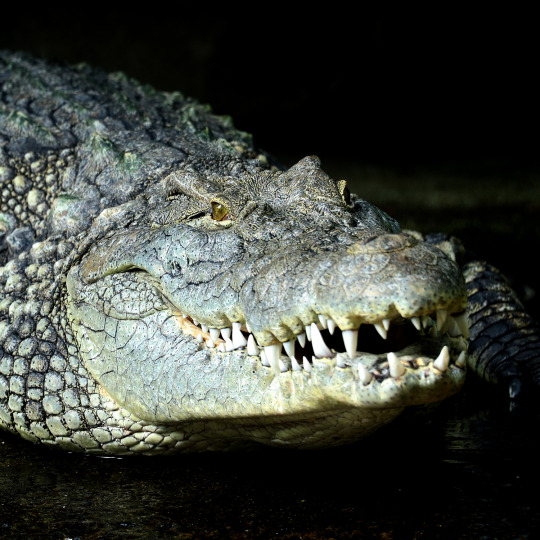
ナイルワニのかっこいい写真が撮れて嬉しい
@東山動植物園
I glad got a cool picture of the Nile crocodile.
@Higashiyama Zoo & Botanical Gardens
19 notes
·
View notes
Text





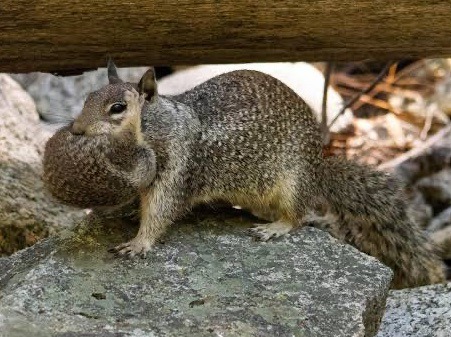

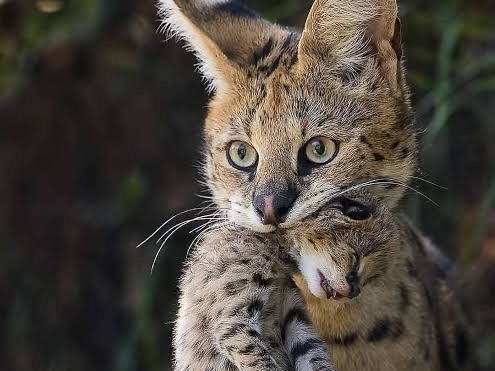


love how universal CHOMPS is
#the baby is always just like okay#☆#🐯#coyote (canis latrans)#arctic fox (vulpes lagopus)#nile crocodile (crocodylus niloticus)#tiger (panthera tigris)#red panda (ailurus fulgens)#rock squirrel (otospermophilus variegatus)#<- i think#cougar (puma concolor)#serval (leptailurus serval)#wolf (canis lupus)#common raccoon (procyon lotor)#canid#vulpes#reptilia#felid#musteloid#rodentia#juvenile
34 notes
·
View notes
Text

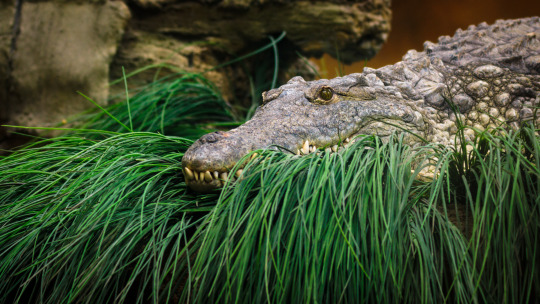


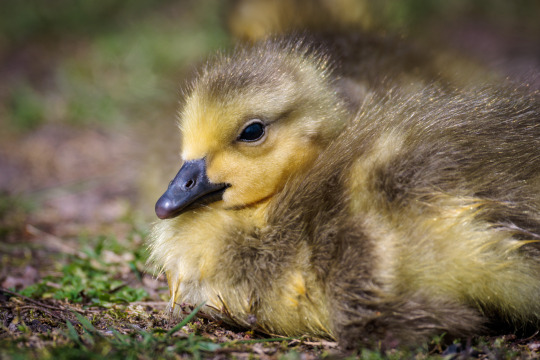
#BeekseBergen#Photography#Photo#Zoophotography#canon#eos#zoo#animal#animals#animalphotography#meerkat#suricata#suricatta#Meerkats#Nile Crocodile#Crocodylus#niloticus#nilecrocodile#croc#crocs#Spotted#Hyena#Crocuta#spottedhyena#hyenas#duck#ducks
8 notes
·
View notes
Text

Nile Crocodile (Crocodylus niloticus), family Crocodylidae, Chobe River, Botswana
photograph by Marco Buegel
475 notes
·
View notes
Photo

Croc-a-doodle doo! ‘Tis the season for eggs, even if this one isn’t eggsactly what you were expecting to see. 🥚An adult Nile crocodile (Crocodylus niloticus) might be a powerful predator, but it starts its life as a tiny hatchling—emerging from an egg that weighs only 4 oz (0.1 kg). Mother crocs lay clutches of nearly 60 eggs in underground nests, guarding them for up to 14 weeks. Fun fact: Nest temperature has a direct effect on the sex of baby crocs. Females hatch from cooler eggs, below 88° F (31° C), while males hatch from warmer eggs!
Photo: Veronik80000, CC BY-SA 4.0, Wikimedia Commons
1K notes
·
View notes
Text
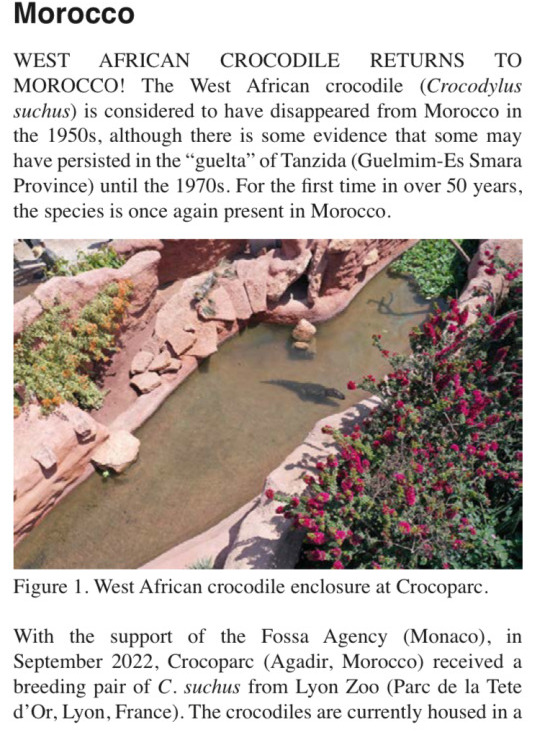
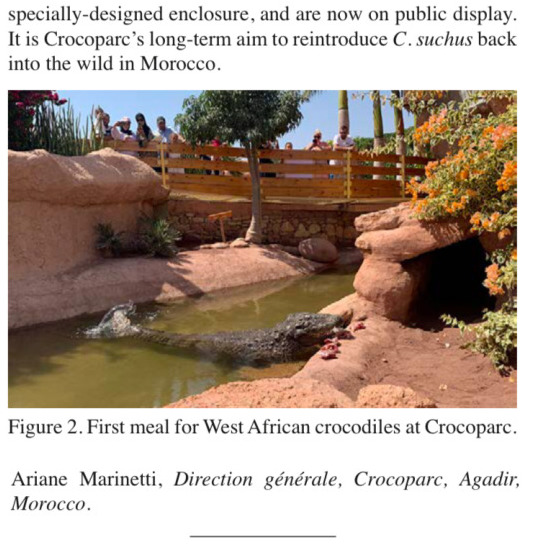
WEST AFRICAN CROCODILE RETURNS TO MOROCCO!
The West African crocodile (Crocodylus suchus) is considered to have disappeared from Morocco in the 1950s, although there is some evidence that some may have persisted in the “guelta” of Tanzida (Guelmim-Es Smara Province) until the 1970s. For the first time in over 50 years, the species is once again present in Morocco.
---
Images, captions, layout, screenshots, and all text above from: Ariane Marinetti. In: Crocodile Specialist Group Newsletter. Volume 41 No. 3. July 2022 -September 2022.
For context:

The West African crocodile is also known to some researchers as the “sacred crocodile” for its association with the deity Sobek and crocodile veneration in ancient Egypt. Though the creature inhabits tropical woodland landscapes across most of West Africa, it is also sometimes described as the “desert crocodile” because of how some populations live in oases in the Sahara, in small pools amidst vast desert. The sites in Morocco where crocodiles were historically reported are at the northern edge of the Sahara, far removed from other contiguous populations of crocodiles in the tropics. Previously, the West African crocodile (Crocodylus suchus) was considered to be the same species as the Nile crocodile (Crocodylus niloticus). Research in recent years has shown that the West African crocodile is a unique species, and it was historically present at sites across North Africa and the Sahara, including at sites in the Tassili n’Ajjer and Ahaggar mountains of Algeria. Crocodiles were reported to have survived in the Draa river system in Morocco until at least the 1940s. Crocodiles were even reported within the 20th century to survive near the Mediterranean coast (!), at Chott el-Djarid in Tunisia. Though both West African crocodiles and Nile crocodiles seem to be present in Egypt, many mummified crocodiles from ancient Egyptian sites have also been determined to be the West African crocodile. At times throughout the Holocene over the past 12,000 years, much of the Sahara featured savanna landscapes, and the “desert’ was home to many rivers and wetlands, now vanished. Even as the desert became dry, some hippopotamus and crocodiles survived in oasis landscapes in isolated parts of the Sahara. Today, some oasis sites in Mauritania provide a cool illustration of this lifestyle, as West African crocodiles still swim in isolated pools, gueltas, tiny spring-fed streams, and small caves surrounded by desert.
739 notes
·
View notes
Text
Wet Beast Wednesday: Nile crocodile
Humans in general often have a fear of large reptiles. This may have an evolutionary advantage as it helped our smaller ancestors avoid large predators like snakes and crocodiles. Whatever the reason, the fear has entered into many belief systems and one common feature in many myths, legends, and religions of Africa and the Middle East is the Nile crocodile. While their reputation as man-eaters is somewhat exaggerated, Nile crocs are one of the most dangerous reptiles to humans, with only the saltwater crocodile matching them in human deaths. However, like most animals, the danger can be avoided if you know what to do and what not to do.
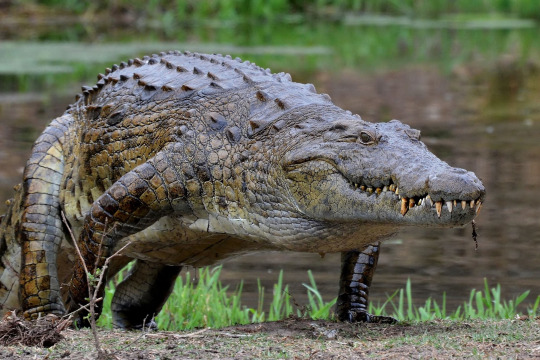
(Image ID: a Nile crocodile walking on land, seen from the front. It is a quadruped with short limbs on the side of its body, scaly skin, and an elongated set of jaws with protruding teeth. The tail is out of view. Its body is dark brown on top and yellowish on the sides. End ID)
The Nile crocodile, Crocodylus niloticus, is the second largest crocodilian and (depending on how you measure some snakes) possibly the second largest living reptile after the saltwater crocodile. Average adult males (which are larger than females) reach between 3.5 and 5 meters (11.5 to 16.5 ft) and and 255 to 270 kg (500 to 1,650 lbs), but some specimens have gotten considerably larger, with the largest confirmed size on record being a male who broke the scale at 6.45 m (21 ft) and between 1,043 and 1,089 kg (2,300 - 2,400 lbs). Nile crocodiles are fairly typical crocodilians. They are large quadrupeds with scaly skin covered with scutes and osteoderms, long and powerful jaws, and eyes, ears, and nostrils on top of their heads. Their eyes are protected with transparent eyelids called nictitating membranes and their skin has many sense organs whose purpose is poorly understood but may help detect changes in water pressure. While on land, the crocodiles are fairly slow and ungainly, but they can swim at high speeds when needed. The broad jaws and powerful muscles give the crocodiles an enormous bite force, being able to bite down on prey with 22 kilonewtons of force. For comparison, humans max out at about 0.7 kilonewtons. This force can also be continuously applies for long periods of time, allowing the crocodiles to hold struggling prey in their mouth and drag it underwater. Famously, though crocodilians can close their jaws with incredible force, the muscles for opening their jaws are much weaker and can be held shut with a person's bare hands or some duct tape. They have dark bronze scales on the back and lighter yellow scales on the sides and underbelly, marked with dark spots. The color darkens as the animal ages. As with all crocodilians, the Nile crocodile has a four-chambered heart that is highly efficient at oxygenating blood and is similar to the hearts of birds. Crocodilians and birds are actually more closely related to each other than they are to anything else still alive. All crocodilians have high lactic acid levels in their blood. This allows them to sit motionless for long periods of time, but increased levels due to overexertion can kill them.

(Image ID: a Nile crocodile resting in the water just offshore, with most of its body still visible. This one is a lighter brown. Its tail is visible. It is long and thick, with two rows of scutes running down it. Its mouth is open. End ID)
Nile crocodiles are found throughout a large portion of Africa and are the most widespread crocodiles, with only the saltwater crocodile having a wider distribution. Their current range is smaller than it used to be and now it is known that areas there were once thought to be part of the Nile croc's range are actually home to the similar species known as the West African crocodile. The West African crocodile was formerly believed to be the same species as the Nile crocodile and was only reclassified in 2011. Their habitat is freshwater lakes, waterways, and swamps throughout Africa. They can tolerate brackish or marine water, but but prefer fresh water. Like other crocodilians, Nile crocs are largely sedentary ambush predators. They can remain motionless for long periods of time, often submerged with only their eyes, ears, and nostrils exposed. A crocodile submerged like this can easily be mistaken for a log. When prey comes close, the crocodile will lunge forward and bite down. Larger prey that is not killed outright will be dragged into the water and drowned. Almost uniquely among crocodilians, nile crocodiles are known to hunt on land. They still employ ambush tactics, usually hiding in brush along paths at night and attacking animals passing by. They have even been known to try to steal kills from land predators and get into tug-of-war battles with lions over pieces of carrion. While clips of a massive crocodile leaping out of the water to drag a zebra to its doom make for entertaining documentaries, about 70% of a Nile crocodile's diet is composed of fish. As an individual grows, larger land animals will make up more of its diet. Nile crocs have been known to cooperate to herd fish into tight spots where they are easier to catch and eat. While famous for their skill and hunting and killing prey, Nile crocodiles are anything but voracious eaters. Their stomachs are pretty small for their size, only around the volume of a basketball. They can also go long periods of time between meals, sometimes several months without signs of starvation. Nile crocodiles are a classic case of apex predators. An adult Nile crocodile has no natural predators, though young ones do get attacked and eaten by larger predators, including other crocodiles. Curiously, they are known to swallow stones. Swallowing stones, known as gastroliths, it a well-known behavior in the animal kingdom. They are usually held in the digestive tract and used to help grind up tough food. Most species that use gastroliths are herbivores or omnivores who use them to help grind up tough plant matter, so it's not clear why the carnivorous crocodiles need gastroliths.

(Image ID: a nile crocodile's had visible above water. Its mouth is open and in it is a silvery fish known as a tilapia. End ID)
youtube
(Video ID: a clip from the BBC Earth showing a Nile crocodile successfully attacking a wildebeest. End ID)
When not attacking prey, Nile crocs are pretty sedentary. They can easily spend most of the day basking in the sun, behavior common to large reptiles who need a long time in the heat to warm their bodies enough to perform daily functions. While basking, they sit on land, often with their mouths open. The open mouths are vital for thermoregulation (a crocodile with its mouth sealed shut can overheat and die), but may also serve as a warning to others who may want to steal their spot. In the southernmost reach of their range, Nile crocodiles may wait out the cool, dry months of May to August by digging burrows and entering aestivation, a state similar to hibernation. Nile crocodiles are social creatures that live, bask, and hunt together. They follow a social order with the largest individual around (almost always an old male) being in charge and having first access to food and the best territory. Males are territorial and will try to force other males out of their range. Larger males will be able to maintain the best territories while smaller males are forced to live on the outskirts. Females are not territorial and will seek out the best male territories to live in. While territorial, crocs of all sizes will come together while basking and their interaction then are mostly peaceful. they are known to communicate through posturing, touch, and vocalizations. Males are known to compete over territory and while most of these competitions are settled through threat displays, they may escalate to violence.

(Image ID: four crocodiles resting on a sandy shoreline. End ID)
Territoriality is especially prominent during mating. The mating season begins around the beginning of the dry season and varies based on location. Males will signal for females with several noises, including bellowing, blowing water out of their noses, and slapping the water with their heads. Males will also attempt to drive other males away to reduce competition. When a female chooses a male, she will approach him and the pair rub their jaws together while making a warbling sound. Males like it rough, roaring and pining the females down, sometimes underwater, while mating. Most males will only mate with a single female each year, though some particularly successful males in certain regions will can multiple mates each year. After two months, the female lays her eggs. While most crocodilians incubate their eggs in piles of rotting leaves, Nile crocodiles use sandy banks or beaches. The female digs a nest, lays up to 80 eggs in it, then buries the eggs. The heat of the sun is used to incubate the eggs and to determine the sex of the offspring. Eggs incubated between 31.7 and 34.5 degrees C will be male. All others will be female. Nests used to be laid extremely close to each other, but but to increased disturbances along the nesting sites, this has become rare. During the incubation period, the mother guards the nest continuously, only leaving to avoid overheating by resting in the shade or entering the water. The father also plays a role, patrolling the area around the nest to drive away predators who would eat the eggs. Incubation lasts about 90 days and the female usually will not eat during this time. The hatchlings will make chirping noises before hatching to signal to the mother that she needs to dig out the nest. Once uncovered, the mother may use her jaws to crack the eggs and assist hatching. Hatchings start at around 280 mm (11 in) long and 70 grams (2.5 oz) and will increase by that rate for the first few years. The mother will protect her offspring for up to two years, often carrying them on her back or in her mouth or throat pouch to keep them safe from predators. The juveniles feed on insects for the first few years of life. Even after leaving their mother, hatchlings will often live in groups until they are large enough to not have to worry about predators. It is estimated that only 10% of eggs hatch and 1% of hatchlings survive to adulthood. Sexual maturity is reached at around 11 to 12 years and the maximum lifespan is estimated to be 70 to 100 years.

(Image ID: a Nile crocodile mother standing at the edge of her nest, a pit in the ground. Multiple white eggs are visible, as are newly-hatched crocodiles, which are far smaller version of an adult. End ID)

(Image ID: Nile crocodile eggs hatching. Four eggs are visible and two are actively hatching, with only the hatchling's heads having emerged. Two other crocodiles have already hatched. End ID)
Nile crocodiles are threatened by habitat loss, pollution, prey loss, bycatch, and human hunting. From the 1940s to the 60s, Nile crocodiles were hunted in massive numbers for the leather trade and were near extinction until new laws, international trade regulations, and conservation efforts largely stopped the hunting efforts. Despite this, their population has not returned to pre-hunting levels and they have been extirpated from many locations. Poaching still happens, as does hunting due to their perceived status as man-eaters, which is actively hindering conservation efforts. Like with sharks, the public image of an animal as being dangerous to humans directly harms its survivability and conservation efforts. Loss of habitat and suitable nesting sites due to damming and other human-caused changes to wetlands have also damaged crocodile populations. An invasive plant, Chromolaena odorata, is harming the crocodiles due to it growing out of control in nesting grounds. The shade from the plants keeps the sun from warming the eggs, causing them to die. Nile crocodiles and saltwater crocodiles are responsible fro the vast majority of attacks on humans and it is estimated that Nile crocs may be responsible for hundreds of deaths (most of them unreported) a year. Only the largest individuals pose a threat to adult humans, though children are at risk to smaller crocs. In fact, Nile crocodiles kill more humans per year through direct attacks than any other wild animal. Those numbers are still dwarfed by deaths due to disease spreading animals, animals acting in self-defense, or attacks or injuries from domesticated animals. For the most part, the crocodiles do not seem to target humans, the number of attacks comes from humans and the crocodiles both living near the water's edge and the crocodiles' nature as generalist predators of large animals. People who study and interact with the crocodiles report that if the right precautions are taken, the danger from being around the animals is negligible and many people and groups have tried to spread safety precautions, especially to poor and remote areas where attacks are likely the most common.

(Image ID: several juvenile Nile crocodiles in a tank being fed. Someone is using a grabber on a stick to drop meat into the tank. Four of the crocodiles are rearing out of the water to get the food. End ID)
#wet beast wednesday#nile crocodile#crocodile#crocodilian#africa#reptile#freshwater biology#freshwater ecology#biology#zoology#ecology#images#image described#cw mentions of death#animal attack#animal facts#Youtube
22 notes
·
View notes
Text

Grzimek's Animal Life Encyclopedia. Volume 6: Reptiles. Written by Bernard Grzimek. 1984. Illustration by Helmut Diller.
1.) Dwarf crocodile (Osteolaemus tetraspis)
2.) False gharial (Tomistoma schlegelii)
3.) Nile crocodile (Crocodylus niloticus)
4.) American crocodile (Crocodylus acutus)
5.) Saltwater crocodile (Crocodylus porosus)
6.) Gharial (Gavialis gangeticus)
#reptiles#crocodilians#dwarf crocodiles#false gharials#nile crocodiles#american crocodiles#saltwater crocodiles#gharials#Helmut Diller
197 notes
·
View notes
Text



Crocodilian skulls from the St. Augustine Alligator Farm. Two large adult Nile crocodiles (Crocodylus niloticus, top and bottom left) and a large adult saltwater crocodile (Crocodylus porosus). These two species are some of the largest true crocodiles to have ever existed. Nile crocodiles are found throughout most of Africa while saltwater crocodiles are found in the Indian subcontinent, Southeast Asia, Indonesia, Papua New Guinea, the Philippines, and northern Australia.
71 notes
·
View notes
Text
Species
There are a total of 18 extant species have been recognized.
American crocodile (Crocodylus acutus)
Hall's New Guinea crocodile (Crocodylus halli)
Orinoco crocodile (Crocodylus intermedius)
Freshwater crocodile (Crocodylus johnstoni)
Philippine crocodile (Crocodylus mindorensis)
Morelet's crocodile (Crocodylus moreletii)
Nile crocodile (Crocodylus niloticus)
New Guinea crocodile (Crocodylus novaeguineae)
Mugger crocodile (Crocodylus palustris)
Saltwater crocodile (Crocodylus porosus)
Borneo crocodile (Crocodylus raninus)
Cuban crocodile (Crocodylus rhombifer)
Siamese crocodile (Crocodylus siamensis)
West African crocodile (Crocodylus suchus)
Osborn’s dwarf crocodile (Osteolaemus osborni)
Dwarf crocodile (Osteolaemus tetraspis)
West African slender-snouted crocodile (Mecistops cataphractus)
Central African slender-snouted crocodile (Mecistops leptorhynchus)

3 notes
·
View notes
Photo
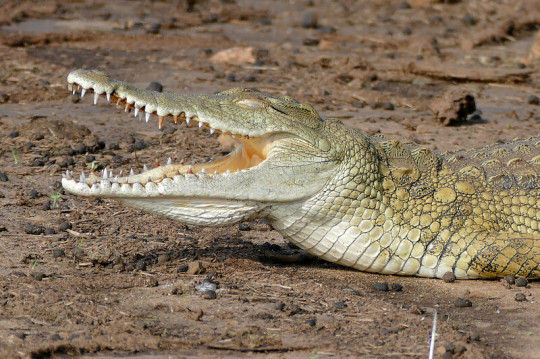
A Nile crocodile (Crocodylus niloticus) in Kruger National Park, South Africa
by Bernard Dupont
#nile crocodile#crocodilians#reptiles#Crocodylus niloticus#Crocodylus#Crocodylidae#crocodilia#reptilia#chordata#wildlife: south africa
285 notes
·
View notes
Text
there is a species of crocodile in the Nile area that is actually very calm and tame. the name of the species is Crocodylus Suchus(or West African Crocodile) and lives in the same area as the most aggressive species of crocodile, Crocodylus Niloticus (or the Nile Crocodile) and they have not mixed DNA at all since they had sparated from the same species about 8 million ears ago(if i am remembering correctly). also, these tame crocs seem to have been kept by the egyptians for ritual use and just for pets(i wouldn't be suprised, i kinda want one too) so that would suggest they could tell the difference between the 2 species, which is really cool
0 notes
Text
Juvenile Nile Crocodile Skull (Crocodylus niloticus)


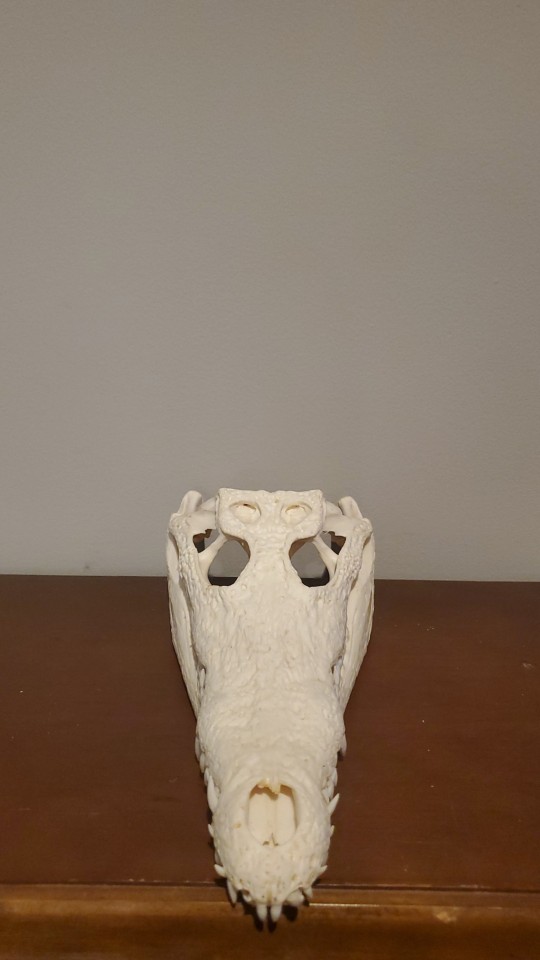
0 notes
Text
10 Mummified Crocodiles Emerge From an Egyptian Tomb
https://sciencespies.com/news/10-mummified-crocodiles-emerge-from-an-egyptian-tomb/
10 Mummified Crocodiles Emerge From an Egyptian Tomb
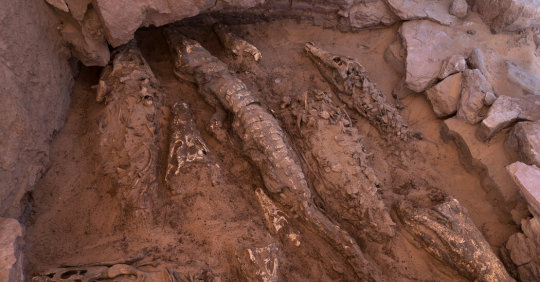
Found beneath an ancient dump, the mummies shed light on ancient Egyptian mummification practices and the many lives of a necropolis.
At first glance, you may think you’re looking at a picture of living crocodiles moving stealthily through mud. But the animals above are mummies, possibly dead for more than 2,500 years and preserved in a ritual that likely honored Sobek, a fertility deity worshiped in ancient Egypt.
The mummies were among 10 adult crocodiles, likely from two different species, the remains of which were unearthed recently from a tomb at Qubbat al-Hawa on the west bank of the Nile River. The discovery was detailed in the journal PLoS ONE on Wednesday.
The crocodile has played an important role in Egyptian culture for thousands of years. In addition to being linked to a deity, it was a food source, and parts of the animal, like its fat, were used as medicine to treat body pains, stiffness and even balding.
Mummified animals, including ibises, cats and baboons, are relatively common finds in Egyptian tombs. Other mummified crocodile remains have been dug up, but most have been juveniles or hatchlings; additionally, the ones discovered in this new study were in great shape.
“Most of the time I’m dealing with fragments, with broken things,” said Bea De Cupere, an archaeozoologist at the Royal Belgian Institute of Natural Sciences and a co-author of the study. “To hear you have 10 crocodiles in a tomb. That’s special.”
Uncovering the Past, One Discovery at a Time
Friends on a Mission: Three hobbyists hunting for Bronze Age rock carvings have transformed Norway’s knowledge about prehistoric art.
Animal Mummies: The discovery of 10 mummified crocodiles in an Egyptian tomb shed light on ancient mummification practices and the many lives of a necropolis.
Meet the Neanderthals: Analyzing fossils from a cave in Russia, scientists have identified the first known family of Neanderthals.
Ancient Tomb: In Lima, home to more than 1,000 archaeological sites, the discovery of pre-Columbian graves is just the latest encounter with an omnipresent past.
She was called to the Qubbat al-Hawa site by a research team led by Alejandro Jiménez Serrano, an Egyptologist from the University of Jaén in Spain. In 2018, researchers uncovered seven small tombs under a Byzantine-era rubbish dump. In one of the tombs — sandwiched between the dump site and four human burials believed to be from around 2100 B.C. — were the mummified crocodiles.
Dr. De Cupere studies everything including bones, teeth and shells as well as coprolites, or fossilized feces, and animal prints. “You have archaeologists doing an excavation and, if they find animal remains that they think are worth looking at, that’s when we come into the picture,” Dr. De Cupere said.

The crocodiles emerged from a small tomb under a Byzantine-era rubbish dump. Video by Patricia Mora Riudavets and José Luis Pérez García.
Of the 10 mummified adult crocodile remains found, five were just heads and the other five were in varying states of completion, but one, at over seven feet long, was nearly complete. Often animal and human mummies are found wrapped in linen bandages secured by resin, which means scientists use techniques like CT scans or X-rays to see through the material. The Qubbat al-Hawa crocodiles contained no resin, and the only fragments of linen present had been all but entirely eaten by insects, allowing the researchers to study the mummies at the excavation site.
Based on skull shape and how the bony plates, or scutes, on the animals were arranged, the team hypothesized that the majority of crocodiles in the tomb appeared to be one species, Crocodylus suchus, while others were Crocodylus niloticus. Salima Ikram, an Egyptologist at the American University in Cairo who was not involved in the study, said that gathering this kind of information provided insight into ancient Egyptian understanding of the distinct behaviors of these two species and which the Egyptians would want to interact with, “because niloticus will eat you, whereas with suchus, you can conceivably swim in the same pool and live,” Dr. Ikram said.
A lack of resin also indicated that the crocodiles were probably mummified by being buried in the hot, sandy soil, where they dried out naturally before being entombed, which the researchers proposed happened before the Ptolemaic period, which lasted between 332 B.C. and 30 B.C.
“From the Ptolemaic period onward, they used huge quantities of resin,” Dr. De Cupere said.
The team hypothesized that the crocodile mummies were buried around the fifth century B.C., when animal mummification was increasingly popular in Egypt. But it will take radiocarbon dating to know for sure. The researchers hope that, in the near future, there will be a chance to perform such dating, as well as DNA analysis to verify the two species.
“The discovery of these mummies offers us new insights into ancient Egyptian religion and the treatment of these animals as an offering,” said Dr. Jiménez Serrano.
Dr. Ikram also views these discoveries as an important window into the relationship between people and the Qubbat al-Hawa necropolis, from the first burials over 4,000 years ago to the present day. “Within the community, how were these tombs viewed? What were their uses?” Dr. Ikram said. “You’re seeing how these tombs had after lives and lives.”
#News
1 note
·
View note
Text
Nile Crocodile (Crocodylus niloticus)
Basking in the sun 🌞
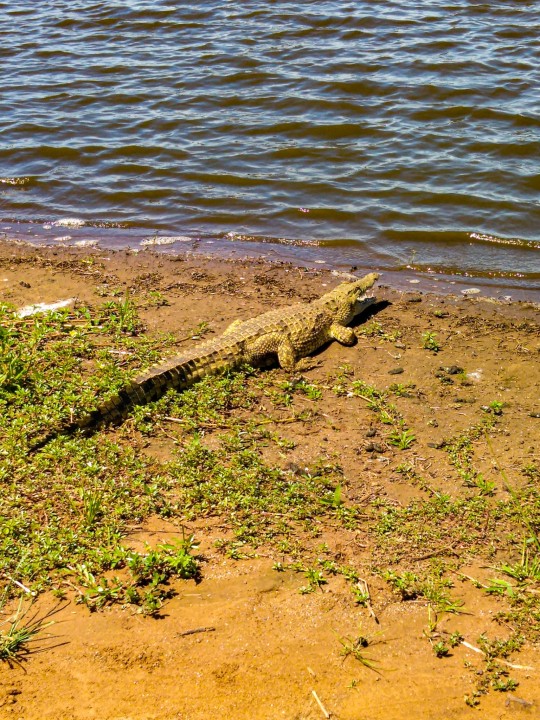
0 notes